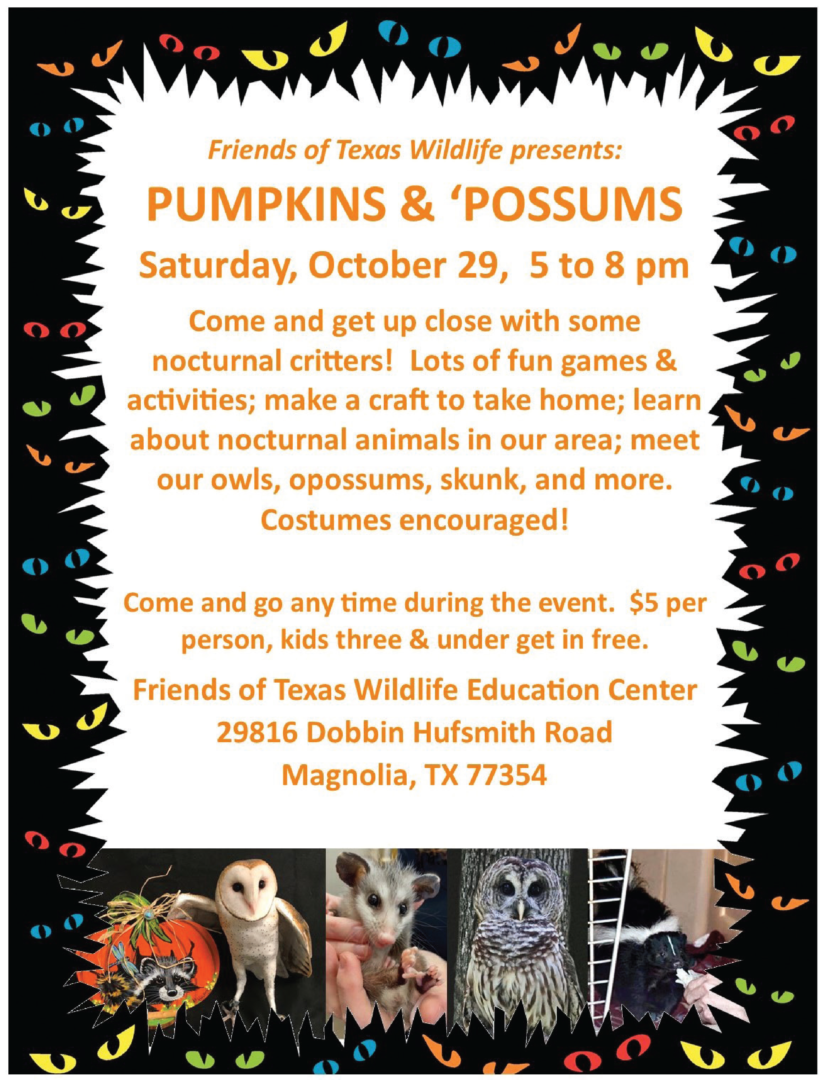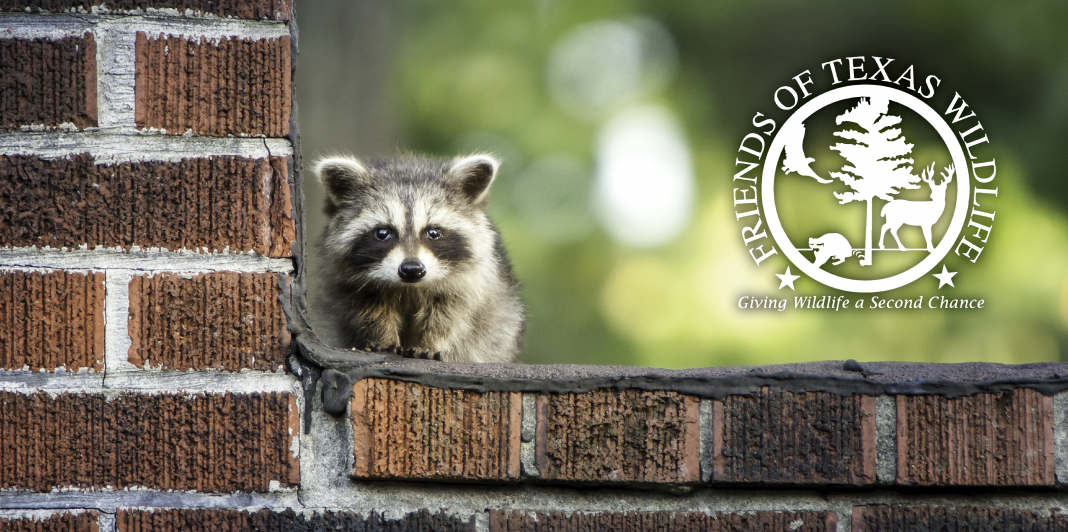Friends of Texas Wildlife: Raccoons; Clever and Mischievous
Raccoons are very common throughout Texas and North America, and they are extremely adaptable to different habitats. In size, they can range from 33 to 45 inches in length and generally weigh 7 to 20 pounds, with urban and suburban animals tending to be larger (due to the accessibility of more food). They are highly curious and intelligent animals best known for the distinctive black mask around their eyes. It is not known for sure what purpose, if any, their mask serves. One theory is that it reduces the glare of incoming light and aids their nighttime vision. Another thought is that the slight differences in the patterns of masks on different raccoons may help them to identify each other as unique individuals. Whatever the reason, it is certainly gives them the appearance of being little nocturnal bandits.

Adult raccoons have excellent vision and an acute sense of hearing and smell. They are excellent climbers and very strong, agile swimmers. Mature raccoons are almost exclusively nocturnal. Seeing a raccoon out during the day could mean that the animal is ill; however, it might simply be a nursing mother or juvenile that is foraging during daylight hours when competition for food is diminished. Young raccoons do not become fully nocturnal until they are close to one year old, and they will often explore and forage during daylight hours while mom is snoozing somewhere close by. If the animal is acting normal, seems wary of people and noises, and isn’t stumbling or falling over, there should not be any cause for concern.
Raccoons have a gestation period of 60 to 74 days. In our area of Texas, raccoon babies (kits) are typically born March through May, and to a lesser extent in late summer. The male raccoon (boar) plays no part in the rearing of the kits. Kits are born with eyes and ears closed, and they are only about the size of a human hand. Litter size is generally three to seven kits, with three or four being average. The kits’ eyes and ears open when they are around 21 days old, and they begin to clumsily walk around at three to four weeks old, but they typically remain in the birth den until they are close to eight weeks old. At that time, they begin exploring with their mom (called a sow). Although they are usually weaned at around three months old, they may remain with their mother through their first winter, not being fully independent until they are close to a year old. During cold winter periods, they may sleep for an extended period, but do not hibernate. Raccoons in the wild can live to be 10 to 15 years old.
The English word “raccoon” is an adaptation of the Native American (Powhatan/Algonquian) word “aroughcun”, which translates to “animal that scratches with its hands”. It was thought for many years that raccoons washed their food; however, that is not the case. They have extremely sensitive front paws with specialized hairs, and sensitivity is increased when the paws are wet. They use this adaptation to feel around in stream beds and ponds for food, easily locating and identify objects by simply by touching them. Their diet includes fruits and nuts, insects and aquatic invertebrates, fish, small rodents, frogs, bird eggs, carrion and (unfortunately) pet food and human trash. This is where they can become a nuisance in urban and suburban areas. Raccoons that lose their natural fear of humans may then move into outbuildings and attics, thereby becoming an issue for homeowners. The best way to coexist with raccoons and not have them become a nuisance is through exclusion and by maintaining a clean space around your home and garden. Never leave pet food out, especially at night; everyone (including wildlife) enjoys a free buffet, but ultimately feeding them will lead to conflicts and overcrowding. Make sure trash cans are secure and cannot be tipped over, and secure lids. Remove hiding spaces (such as large wood and brush piles), and block entry points into your home or outbuildings. Keep large trees and limbs trimmed away from your home and roof (remember raccoons are great at climbing) to make your roof and attic less accessible.
When raccoons are left to fend for themselves and forage natural foods, they do offer certain benefits to your yard and the environment around us. As omnivores, they eat a large variety of foods, so they can keep the area free of pests such as small rodents, insects, snakes, grubs, and worms. They will also clean up carrion. When they dig during their search for food, like all mammals of this type, raccoons help soil turnover, which promotes decomposition. Since they also eat berries, fruits, nuts, etc., they help spread the seeds of those plants and trees when they expel them, thereby helping to reforest areas. Lastly, believe it or not, raccoons are “bee friendly”! We all know that in many areas, bees are threatened, and they are vitally important as pollinators. We depend on the bees for plants and crops to continue to thrive and produce. One of the main dangers to bees are wasps. Wasps are larger and can be quite aggressive, and they sometimes prey on bees. Certain varieties of wasp, including yellowjackets, will attack and kill honeybees as a source of food for their young. Wasp larvae happen to be a favorite food of raccoons, so by controlling the wasp population they consequently prevent wasps from colonizing the environments in which they are found, which thereby provides protection for beehives. All of these are good and valid reasons to not feed raccoons; by letting them fend for themselves, they and the surrounding environment will remain balanced and healthy.
To learn more about what we do and view pictures of many of the animals we assist, please visit our Facebook page at www.facebook.com/SavingTexasWildlife. Details and more specifies-specific flowcharts regarding how to help found animals can be viewed on our website at www.ftwl.org (click on “Help and Advice”). These charts are extremely helpful to determine if an animal truly needs rescuing or not. If you need assistance with a wildlife animal you have found, please call us at 281-259-0039 or email us at [email protected]. We offer many educational programs (including camps, birthday parties, educational presentations, and Second Saturdays).
NEW THIS YEAR; PUMPKINS & ‘POSSUMS,

on Saturday, October 29 from 5 to 8 PM (come and get up close with some nocturnal animals, including owls, opossums, skunks, and more). Pumpkins & ‘Possums will be held at our educational center, $5 per person (kids three and under free), come and go any time 5 to 8 pm. Additionally, our educational visitor’s center is open the second Saturday of each month from 10 a.m. to 2 p.m., located at 29816 Dobbin Hufsmith Road, Magnolia, Texas, so our next Second Saturday will be on October 8
($5 per person, kids three and under are free).















